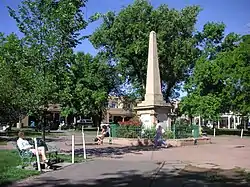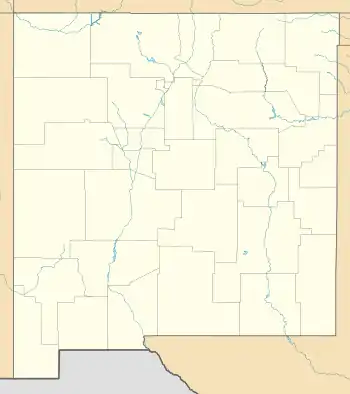Santa Fe Plaza
The Santa Fe Plaza is a National Historic Landmark in downtown Santa Fe, New Mexico in the style of traditional Spanish-American colonial cities. The plaza, or "city-square", was originally, and is still to this day, the center gathering place in town. Many know it as "the heart of Santa Fe". The landmark has since grown into a playground for many tourists interested in Spanish, Native American, and Mexican cultures, and includes music, design, jewelry, art and dance. Known to locals simply as the "Plaza," it is home to annual events including Fiestas de Santa Fe, the Spanish Market, the Santa Fe Bandstand, and the Santa Fe Indian Market.
Santa Fe Plaza | |
 Santa Fe Plaza in 2006 | |
  | |
| Location | Santa Fe Plaza, Santa Fe, New Mexico |
|---|---|
| Coordinates | 35°41′14.7474″N 105°56′18.6714″W |
| Area | 2 acres (0.81 ha) |
| Built | 1821 |
| Part of | Santa Fe Historic District (ID73001150[1]) |
| NRHP reference No. | 66000491[1] |
| NMSRCP No. | 260 |
| Significant dates | |
| Added to NRHP | October 15, 1966 |
| Designated NHL | December 19, 1960[2] |
| Designated CP | July 23, 1973 |
| Designated NMSRCP | September 29, 1972 |
Listed on the National Register of Historic Places, the plaza consists of a central park lined with grass, trees, and benches. During Christmas time, the plaza is decorated with farolitos, luminarias, and trees lights. The park also includes a performing arts stage.
History
Encompassed in the general plaza area are historic monuments, restaurants, businesses and art galleries, including the Palace of the Governors (the oldest public building in the U.S.), the New Mexico Museum of Art, Cathedral Basilica of Saint Francis of Assisi, and the Loretto Chapel. In true pueblo fashion, the Plaza architecture is traditional adobe. Just 16 miles (26 km) from the Santa Fe ski basin, the Plaza dates back to the early 17th century when Santa Fe was settled by conquistadors. Until the mid-19th century, the Plaza lacked landscaping, and ownership of the area transitioned between the Spaniards and the Mexicans throughout the earlier years.[3]
Pre-Columbian era
The area now known as Santa Fe had been inhabited by Tewa and other peoples, for which there is archaeological evidence as near to the Plaza as the Sena compound.[4]
Spanish era
All Spanish colonial towns with a regional governor's office (for Santa Fe de Nuevo México, that was the Palace of the Governors) were required by the civic planning section of the laws of the Indies to have a Plaza de Armas to marshal the palace guard in. The original Plaza was a presidio surrounded by a large defensive wall that enclosed residences, barracks, a chapel, a prison and the Governor's palace. Eventually the wall gave way to large houses built by high-ranking Spanish officers and officials. In the early days, it was found at the end of El Camino Real (the Spanish Royal Road from Mexico City).[5]
Mexican era
With Mexico's Independence from Spain, in 1821, the Santa Fe Trail, a trade route connecting New Mexico with Missouri, was opened with its western terminus at the Santa Fe Plaza. Overland wagon caravans used the plaza to camp and unload trade goods. The Old Pecos Trail also passed nearby before it was rerouted.[6]
U.S. territorial era
After the New Mexico Territory was established, a fence was built around the plaza to keep out animals. Trees were also planted and pathways were introduced. A bandstand was added at various locations over time, as was the "Soldiers' Monument" in the plaza center.[7]
U.S. statehood
After New Mexico was admitted as the 47th state in 1912, a historic preservation plan was established. The plaza is now marked by structures in the Pueblo, Spanish and Territorial styles that reflect its history. Among the most noted are the original palacio, the Palace of the Governors, built between 1610 and 1612 and San Miguel Mission, a noted landmark (c. 1640), and one of the oldest churches in the United States.[8] The plaza is surrounded by restaurants, shops, and museums. Many seasonal community events are held at the plaza, and it is then filled to capacity with people enjoying the magic that is 'The City Different'.[9]
Points of interest
The Plaza has several mature trees, street lamps, a banco, a central monument, a buried time capsule[10], a bandstand and a water fountain. Wireless internet access is also available as of 2019.
See also
References
- "National Register Information System". National Register of Historic Places. National Park Service. July 9, 2010.
- "National Historic Landmarks Survey, New Mexico" (PDF). National Park Service. Retrieved January 7, 2017.
- Santa Fe Plaza
- Noble, David, ed. (1989). "Frances Levine, Down Under an Ancient City: An Archeologist's View of Santa Fe". Santa Fe, History of an Ancient City. Santa Fe: School of American Research. pp. 9–25. ISBN 0-933452-26-8.
- "El Camino Real de Tierra Adentro National Historic Trail". National Park Service. Retrieved 5 February 2021.
- Santa Fe National Historic Trail, National Park Service
- Wilson, Chris (1997). The Myth of Santa Fe, Creating a Modern Regional Tradition. Albuquerque: University of New Mexico Press. pp. 58, 60. ISBN 978-0826317469.
- Santa Fe Plaza-American Southwest-A National Register of Historic Places Travel Itinerary
- Santa Fe Plaza
- "The New Mexican". 5 November 1867. Retrieved 2 February 2021.